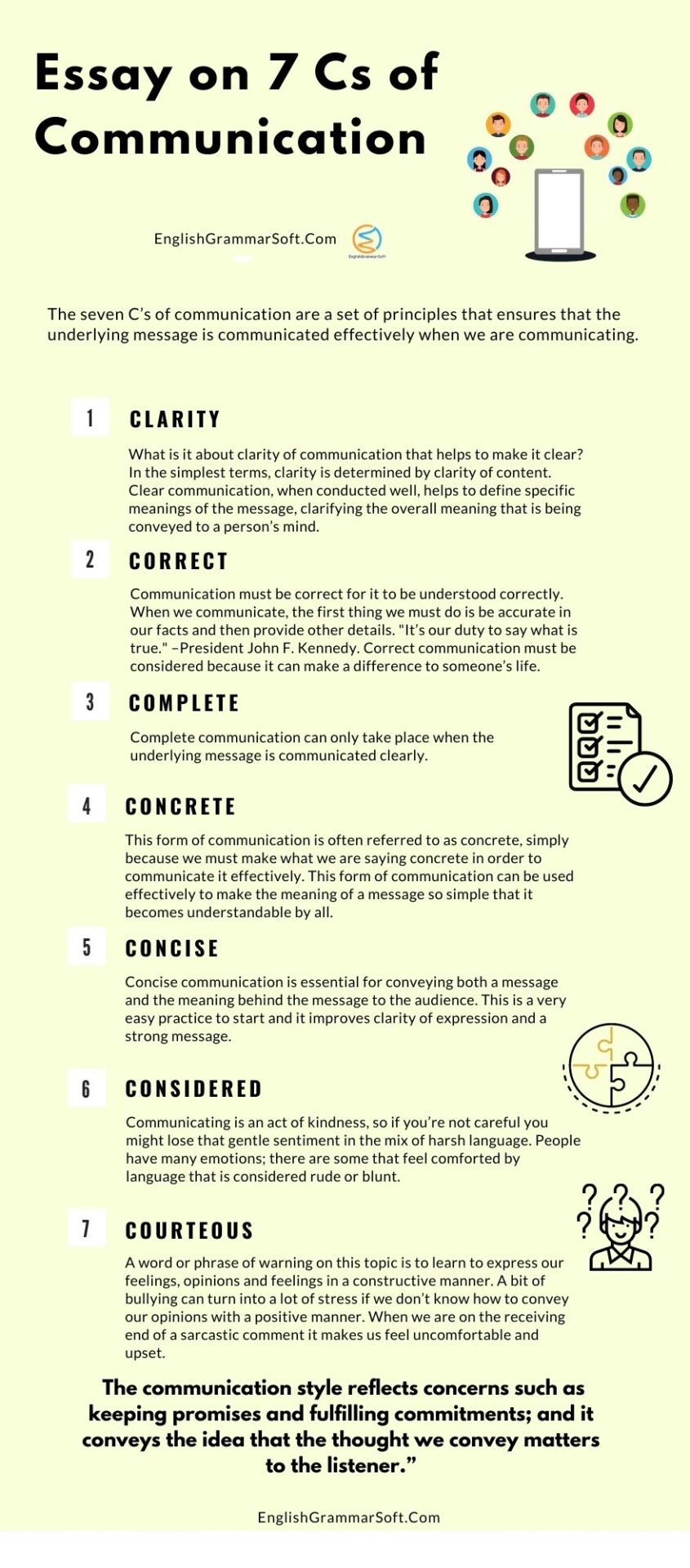Essay on 7 Cs of Communication
Professional communication is a skill that develops over time. Communication can take many forms, from writing to speaking to creating videos. Each approach has value but so does the combination of skills used to achieve the communication message.
The seven C’s of communication are a set of principles that ensures that the underlying message is communicated effectively when we are communicating.
The seven C’s of good communication are clear, correct, complete, concrete, concise, considered and courteous.
Essay on 7 Cs of Communication
1. Clarity
What is it about clarity of communication that helps to make it clear? In the simplest terms, clarity is determined by clarity of content. Clear communication, when conducted well, helps to define specific meanings of the message, clarifying the overall meaning that is being conveyed to a person’s mind.
Communication that is unclear and lacks clarity is only expressed through fuzzy language, long, complicated sentences, and non-constructive wording, leaving the impression that the message is meant in a vague manner. This sends the message that the listener can create his or her own interpretation. In essence, if the message is ambiguous, listeners will not know what it is meant to mean. When writing communication, clarity is just as important.
2. Correct
Communication must be correct for it to be understood correctly. When we communicate, the first thing we must do is be accurate in our facts and then provide other details.
“It’s our duty to say what is true.” –President John F. Kennedy. Correct communication must be considered because it can make a difference to someone’s life.
3. Complete
Complete communication can only take place when the underlying message is communicated clearly. The following areas are vital for effective communication:
- Spelling and Grammar: Spelling and grammar are very important. Poor spelling can cause significant errors to be misinterpreted or misquoted. Spelling and grammar are very important. Poor spelling can cause significant errors to be misinterpreted or misquoted.
- Pronunciation: Effective communication requires a clear understanding of how to pronounce each word, without making mistakes. Effective communication requires a clear understanding of how to pronounce each word, without making mistakes.
- Hyphenation: Hyphenation is the act of putting a period at the beginning of two words.
4. Concrete
This form of communication is often referred to as concrete, simply because we must make what we are saying concrete in order to communicate it effectively. This form of communication can be used effectively to make the meaning of a message so simple that it becomes understandable by all.
For example, instead of saying “I want a new computer,” say “I would like a new computer.” This language that helps you communicate with the other person what you want to convey is what is called “direct communication.” The Direct Message Concrete communication works with the person to whom we are communicating in order to make the message clear.
We can use phrases such as, “I would like a new computer,” “I want you to do something for me,” or “I want you to take me to the beach”.
5. Concise
Concise communication is essential for conveying both a message and the meaning behind the message to the audience. This is a very easy practice to start and it improves clarity of expression and a strong message.
There are a number of ways to improve the use of concise communication. The most obvious is to limit the number of words in a communication, but that is only one of the factors that can affect the clarity of message. Focusing on the message, one word at a time, will assist in the formation of better, clearer thoughts.
It also helps that it is easy to use, especially when using small words. Using simple, short words and phrases like simple, short, and clear allows for greater clarity of meaning.
6. Considered
The inclusion of the word ‘consider’ in the previous statement is because there are three different levels to consider when communicating.
First and foremost, we should consider the effect that the message has on the recipient, or to put it another way, we should consider the feelings and beliefs that the message is likely to generate in the receiver.
I find it amazing that many people think they are being straightforward when they are not, just because they have not actually thought about how their communication is going to be received.
Communicating is an act of kindness, so if you’re not careful you might lose that gentle sentiment in the mix of harsh language. People have many emotions; there are some that feel comforted by language that is considered rude or blunt.
7. Courteous
When we are courteous we communicate to a good standard. We are precise, action-oriented, considerate and respectful.
We are clear, we do not make excuses, we get our information and facts straight. We remember to be courteous by putting in the effort, not holding ourselves back. There is nothing worse than when we feel good and express our views then our tone changes as soon as someone else appears in the conversation or we become irritated.
A word or phrase of warning on this topic is to learn to express our feelings, opinions and feelings in a constructive manner. A bit of bullying can turn into a lot of stress if we don’t know how to convey our opinions with a positive manner. When we are on the receiving end of a sarcastic comment it makes us feel uncomfortable and upset.
Conclusion
The words you choose and how you say them affect how the receiver understands you and what you mean to say. Whether your message is from a friend, co-worker, or family member, every word you choose impacts the way the receiver believes and interprets what you have said.
If you communicate with people whom you know not to understand what you are saying, such as a foreign language student, relatives you don’t understand, or colleagues who seem to misunderstand you, you may not get where you are going with your communication.
Choosing the wrong words and understanding the wrong things in your communication can lead to lost opportunities, misunderstandings, and frustrated interactions with others. To clarify a message that is not clear can lead to frustration and missed opportunities.
“The reason for communicating as such falls into four topics: completion, clarity, creativity, and courtesy. In context, you are perhaps criticized if you do not fulfill these criteria — in other words, you don’t communicate clearly. This communication style reflects concerns such as keeping promises and fulfilling commitments; and it conveys the idea that the thought we convey matters to the listener.”
The Seven C’s All stem from the development of grammar and usage. Grammar follows the rules. The “rules” often work so well, making almost every sentence sound good (and memorable).

Further Reading
- How to Write an Essay | Structure of Essay (Comprehensive Guide)
- Essay on Happiness is State of Mind
- Essay on Education
- Essay on importance of education
- Essay about Anxiety and Stress
- Essay on Time Management
- Essay on 8 Business Functions
- Essay on Personality Development
- Essay on Importance of water in life
- Essay on Why Trees are Important in our Life
- 500 Words Essay on Nature in English
- Essay on Global Warming Causes and Effects
- Essay on Deforestation
- Essay on Smoking is bad for health
- A Short Essay on Mothers Day
- Essay on Health is Wealth






